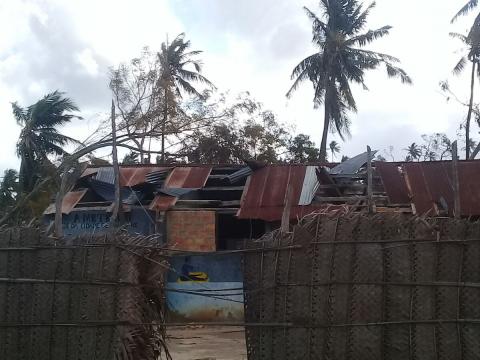Tropical storm Dineo leaves a trail of destruction; World Vision responds

The scenario as you enter Inhambane is devastating. Roofs blown up from the houses, destroyed public and private buildings, countless trees down all over the road. Seven people were declared dead and an estimated 635,000 affected.
Crimilda José, 14, is inconsolable. Although, her home was spared from damage, many of her friends lost homes and their school’s roof has been blown away. She is worried how they will go back to the classrooms.
“When I went out of the house after the strong winds, I saw the roof of our school gone and all over the place. The water tanks got toppled from their place and destroyed,” Crimilda says.
“I walked around my village and I saw a lot of houses and trees destroyed. I was so sad to learn that the houses of my friends were blown away”, she adds.
The devastation in her village started afternoon last Wednesday when strong winds at the speed of 170km per hour along with the heavy rains pounded her village. It left a trail of destruction that shocked many of the people Crimilda knows.
“It started at about 3:00pm. I was afraid. It was my first time I experienced a storm that strong. There was a lot of noise outside. My mother kept us inside the house until the following day,” she says.
The city went on a blackout after electricity poles went down along with the communications lines. Now, only some parts of the province has electricity as the authorities are working to restore the services.
“I don’t know where we will study. We can’t even sit under the trees because all of them have fallen down. “I am glad the storm has gone. I hope it will never come back,” Crimilda shares.
“The destruction is massive”, Elidio Jamisse, World Vision’s staff on the ground, says. He joined the multi-sectoral team who were immediately sent to assess the impact of the tropical storm in Inhambane province.
“About 90 percent of the schools we have seen along the way were roofless. Children will not be able to go to school for quite some if time no classrooms are provided for them”, he adds.
“Many people were affected by the El-Nino-induced drought and just when they were recovering, the rains started to come and their crops hardly survived. Now the storm came and destroyed what was left of their efforts”, he further says.
After preliminary assessment, the Mozambican government requested for tarpaulins, big tents for schools and hospitals, food assistance, household kits and water purification supplies. They also raised the need for assistance of seeds for the next agricultural season.
World Vision has prepositioned 2,000 emergency kits composed of tarpaulins, buckets, ropes, mosquito nets, water purifiers, blankets, and toiled slabs.
The kits will be distributed through Welthungerhilfe, a World Vision partner and member of Mozambique Humanitarian Consortium (CHEMO). CHEMO is a consortium composed of Food For the Hungry, Welthungerhilfe and World Vision.
“The urgent assistance cannot be done by just one organization and the government so we are working with our partners to ensure the needs of the people are quickly addressed. After the drought, it was difficult for the people to recover and now with the storm, it makes recovery even harder. They need our help”, appeals Graham Strong, national director for World Vision Mozambique.


